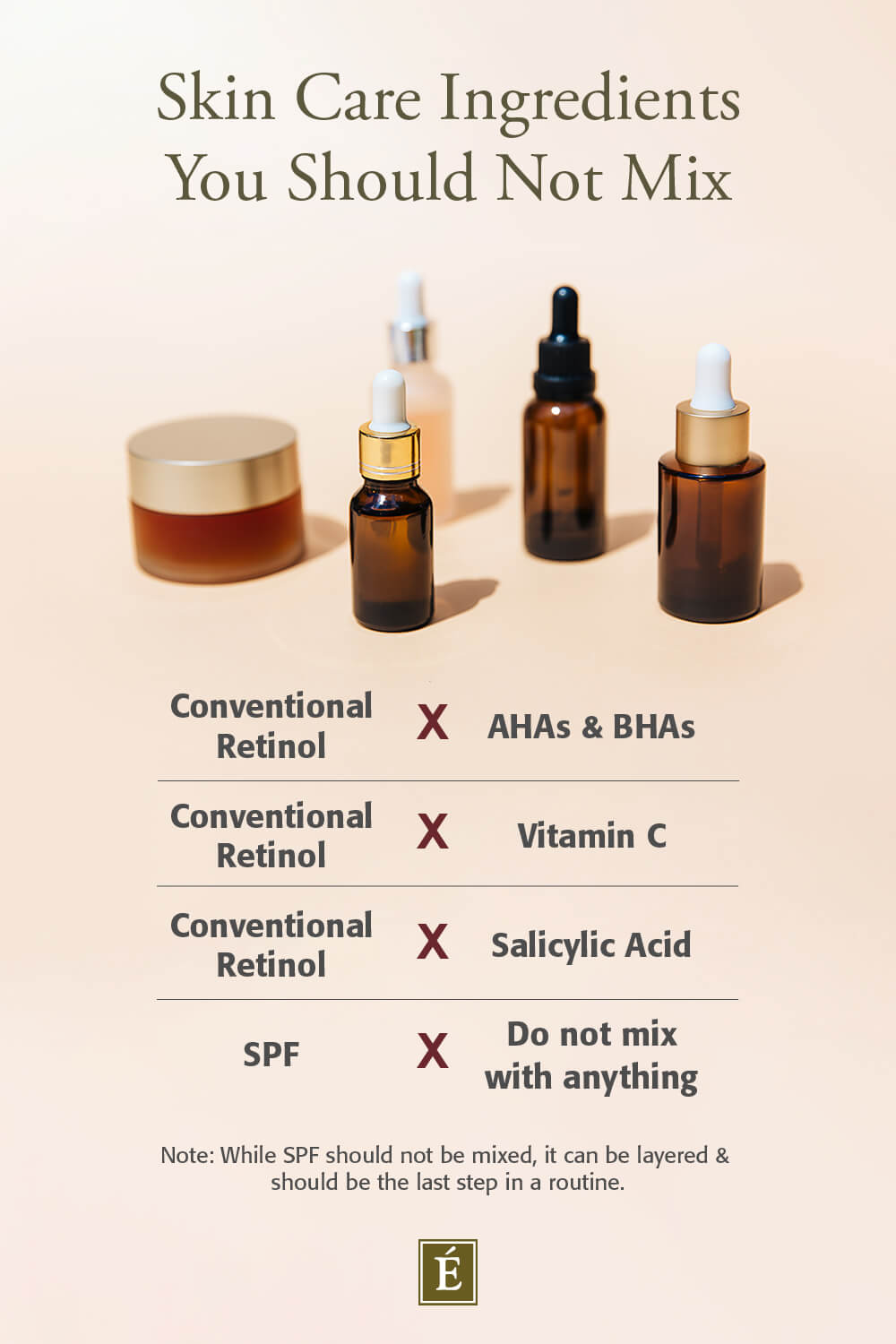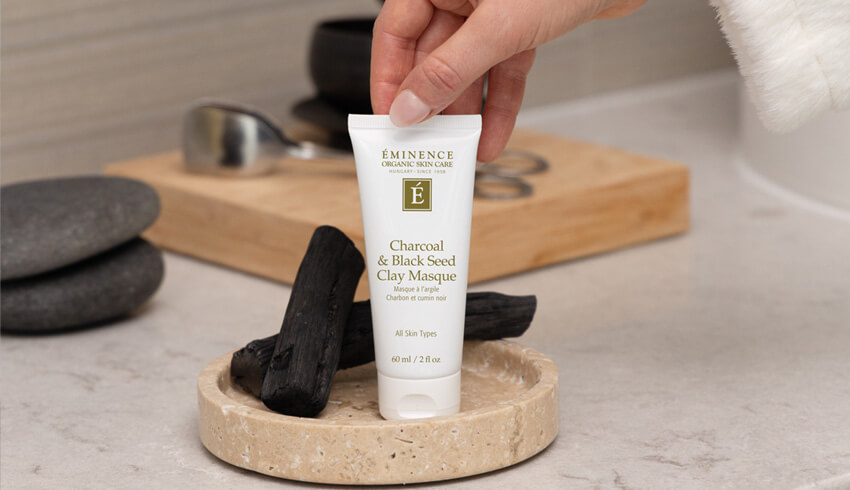
It’s no secret that you can supercharge your skin care by combining various high-impact ingredients for maximum results. But unfortunately, not all skin care combinations play well together. While some ingredients come together and happily complement each other, others just don’t get along — which can wreak havoc on your skin. With our handy guide, you can minimize the likelihood of skin-damaging product pairings and embrace dream skin care partnerships. Read on to find out more.
FAQ: Mixing Skin Care Ingredients
Can You Mix Skin Care Ingredients?
“Mixing some strong topicals, such as conventional retinol, with certain ingredients will increase the potential to irritate the skin,” explain our Product Support Representatives. “This can reveal itself through increased sensitivity in touch, heat, redness, dryness, peeling and itchiness."
We suggest that you exercise strict caution with topicals that can be prescribed, such as conventional retinol. Each individual’s ability to test and try mixologies is entirely dependent on their skin's current condition. If you have been advised by a medical professional to avoid certain ingredients, please follow your medical professional’s advice.
What Skin Care Ingredients Work Best Together?
The following ingredient combos work beautifully together:
- Conventional retinol and hyaluronic acid
- Vitamin C and niacinamide
- Salicylic acid and hyaluronic acid
- Layering (not mixing) vitamin C and SPF
- Surprise, niacinamide mixes with everything!
What Skin Care Should Not Be Mixed Together?
- Conventional retinol and AHAs and BHAs
- Vitamin C and conventional retinol
- Salicylic acid and conventional retinol
- Don’t mix SPF with anything!
Let's Talk About Conventional Retinol
While conventional retinol might be the ingredient on everyone’s lips, it poses significant issues. According to Everyday Health, conventional retinol/retinoids stimulate skin cell turnover which manifests physically as an intense exfoliation to reveal new skin underneath. This can lead to dryness, irritation and even peeling. Although conventional retinol is strong enough to cause damage when used on its own, and even more so when paired with the wrong product. When in doubt, don’t mix or layer conventional retinols with anything you’re unsure of. You can also reach out to a spa professional for clarity.
It’s important to note that Eminence Organics products do not contain conventional retinol. Conventional retinol is a synthetic chemical derived from Vitamin A which may dry up your skin and cause peeling when overused.
Eminence Organics products contain two retinol alternatives: bakuchiol, which is the extract from the leaves and seeds of the babchi plant, and our Natural Retinol Alternative, which is derived from botanical extracts of the tara tree and chicory root. Mixing products with these ingredient is no issue! Products containing bakuchiol and Natural Retinol Alternative can be safely used with other skin care products without risking the side effects mentioned above, such as irritation, dryness, purging or peeling. However, if conventional retinol is your ingredient of choice, read the following guide to avoid risky pairings with conventional retinol and other potent ingredients.
Mixing Skin Care Ingredients

Conventional Retinol
Do Mix: Conventional Retinol & Hyaluronic Acid
Unlike conventional retinol, there aren’t many products that don’t agree with hyaluronic acid, which is why we’re so pleased to tell you these two make a lovely team. Hyaluronic acid’s hydration benefits pair wonderfully with the drying nature of conventional retinol. A hyaluronic acid serum or even moisturizer can counteract the drying effects of conventional retinol, working to reduce the effects of any irritation and helping the skin replenish and rehydrate.
Don’t Mix: Conventional Retinol & AHA & BHA
Beta hydroxy acids (BHAs), alpha hydroxy acids (AHAs) and conventional retinol all work by stimulating cell turnover through exfoliation. It's no wonder that using these types of exfoliating ingredients with conventional retinol is a no-no. The combination can lead to serious over-exfoliation, dry, irritated skin, and can even damage the skin barrier over time.
However, if you find yourself loyal to these products, you don’t have to abandon one for the other. Simply avoid using your conventional retinol and BHA or AHA products at the same time. Either alternate your product usage to different days or use your conventional retinol at night and your BHA and AHA throughout the day. It’s worth noting that retinoids have to be used in the evening due to the increased UV sensitivity they cause.
Vitamin C
Do Mix: Vitamin C & Niacinamide
We love both niacinamide and Vitamin C separately for their general ease of use and many benefits. But together, they’re even better. Some recent skin care myth-busting debunked the once widely held belief that the two should not be used together, an idea that originated from research in the 1960s that is no longer relevant to how we use and store products today. The news is very exciting considering that this powerful duo offers hydration, brightening and skin-smoothing benefits from both ingredients.
Don’t Mix: Vitamin C & Conventional Retinol
Unfortunately, Vitamin C and conventional retinol aren’t compatible either. Combining the two can lead to redness, irritation and peeling. Plus, the combination can make skin sensitive to the sun (already an issue posed by using retinol in the AM). There’s also a risk of conventional retinol messing with the pH of the Vitamin C which can destabilize the product, potentially rendering it inactive as a skin care ingredient.
The fix here is easy though. Conventional retinol is best suited to a nighttime routine, away from any UV light and left to soak into the skin through the night. Vitamin C is better for daytime use due to its ability to combat the damage left by environmental stressors like UV rays and pollution. Always layer an SPF over the top to protect from sun damage and make sure to rinse your face in the morning to remove any residual retinol from the night before.
Niacinamide
Do Mix: Surprise, Niacinamide Mixes With Everything!
According to our Product Support Representatives, “You’re welcome to combine niacinamide with almost every skin care ingredient and product. We can suggest using it with retinols, hyaluronic acid, AHAs, BHAs and Vitamin C.”
Salicylic Acid
Do Mix: Salicylic Acid & Hyaluronic Acid
Salicylic acid pairs well with hyaluronic acid. Hyaluronic acid deeply hydrates and helps the skin retain moisture for a balanced complexion, while salicylic acid exfoliates and reduces inflammation. Combining these ingredients provides you with the benefits of each and results in clearer, smoother and more hydrated skin.
Don’t Mix: Salicylic Acid & Conventional Retinol
In theory, using salicylic acid and conventional retinol at the same time makes sense; salicylic acid clears breakout-prone skin while retinol softens fine lines. However, this is not a combination we'd recommend trying. It shouldn't surprise you to read that using salicylic acid and conventional retinol together does increase the chance of drying out the skin and can lead to irritation. What may be surprising is that this combination can result in the skin overproducing oil to compensate for this new dryness leading to even more breakouts. This catch-22 is solved by separating the two products. Use your salicylic acid products to treat breakout-prone skin during the day (it’s perfectly safe) and keep all retinol usage to nighttime.
You can also watch our Lead Skin Care Trainer, Natalie Pergar, discuss the skin care ingredients you should not mix in further detail in this In The Mix video.
SPF
Do: Layer (Not Mix) SPF With Vitamin C
Fun fact: there’s some research to support that a Vitamin C product sitting under a good sunscreen can add additional protection against the sun. So, don't forget to apply your Vitamin C serum beforehand to layer — not mix — with your sunscreen.
Don’t Mix: SPF With Anything
Although you can layer SPF over almost any skin care products (and you should, every day!), it shouldn’t be mixed in with any other products before applying. SPF is considered by many to be the most important product in your daily skin care routine and retaining your SPF product’s integrity is paramount for its efficacy as a guard against the sun and UV light. This is one product that can't be improved by mixing with other skin care products and we'd advise against mixing it in with makeup or moisturizer. We recommend letting your skin care products settle into the skin, then layer the sunscreen on top as the last step in your routine.
Tips On Mixing Your Skin Care Products
It's crucial to exercise caution while combining skin care products to prevent any negative skin reactions. Follow these tips:
- First, consult our list above to check for ingredients that are not compatible.
- Perform a patch test on a tiny area of your skin to check for an allergic reaction or signs of irritation.
- Start with a small amount of each skin care product and gradually increase the amount to avoid overloading your skin.
- To prevent contaminating the entire product, mix the ingredients in the palm of your hand rather than in the product container.
Learn about other powerful skin care ingredient combinations by visiting your nearest Eminence Organics spa.


